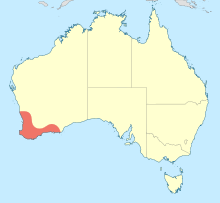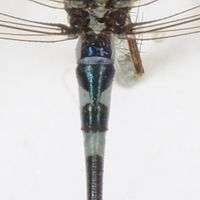Austrolestes aleison
Austrolestes aleison is an Australian species of damselfly in the family Lestidae,[3] commonly known as a western ringtail.[4] It is endemic to south-western Australia, where it inhabits pools, ponds and lakes.[5]
| Western ringtail | |
|---|---|
| Scientific classification | |
| Kingdom: | Animalia |
| Phylum: | Arthropoda |
| Class: | Insecta |
| Order: | Odonata |
| Suborder: | Zygoptera |
| Family: | Lestidae |
| Genus: | Austrolestes |
| Species: | A. aleison |
| Binomial name | |
| Austrolestes aleison | |
 | |
Austrolestes aleison is a medium-sized to large damselfly, the male is blue and black.[6]
Etymology
The word aleison is from the greek word ἄλεισον, meaning a goblet. In 1979, Tony Watson and Max Moulds named this species of damselfly after the goblet-shape of the mark on segment 2 of the male abdomen.[2][7]
Gallery
 Goblet shape on the tail of a male Austrolestes aleison
Goblet shape on the tail of a male Austrolestes aleison.jpg) Female wings
Female wings_(2).jpg) Male wings
Male wings
gollark: Where'd you get *that* from?
gollark: Thɑnks, Unicode Consortium!
gollark: I hɑve corrected my nɑme ɑccordingly.
gollark: And yet it has "a" in the name, objectively* the worst letter of the alphabet.
gollark: Quality, not quantity! The transistor cult is obviously the best cult, and also we have spies in basically all electronic equipment in existence.
See also
References
| Wikimedia Commons has media related to Austrolestes aleison. |
| Wikispecies has information related to Austrolestes aleison |
- Dow, R.A. (2017). "Austrolestes aleison". IUCN Red List of Threatened Species. 2017: e.T14676531A59256818. doi:10.2305/IUCN.UK.2017-1.RLTS.T14676531A59256818.en.
- Watson, J.A.L.; Moulds, M.S. (1979). "New species of Australian Lestidae (Odonata)". Journal of the Australian Entomological Society. 18 (2): 143–155 [144]. doi:10.1111/j.1440-6055.1979.tb00828.x.
- "Species Austrolestes aleison Watson & Moulds, 1979". Australian Faunal Directory. Australian Biological Resources Study. 2012. Retrieved 9 April 2017.
- Theischinger, Günther; Hawking, John (2006). The Complete Field Guide to Dragonflies of Australia. Collingwood, Victoria, Australia: CSIRO Publishing. p. 30. ISBN 978-0-64309-073-6.
- Theischinger, Gunther; Endersby, Ian (2009). Identification Guide to the Australian Odonata (PDF). Department of Environment, Climate Change and Water NSW. p. 204. ISBN 978-1-74232-475-3.
- Watson, J.A.L.; Theischinger, G.; Abbey, H.M. (1991). The Australian Dragonflies: A Guide to the Identification, Distributions and Habitats of Australian Odonata. Melbourne: CSIRO. ISBN 0643051368.
- Endersby, I. (2012). "Watson and Theischinger: the etymology of the dragonfly (Insecta: Odonata) names which they published". Journal and Proceedings of the Royal Society of New South Wales. 145 (443 & 444): 34–53 [37]. ISSN 0035-9173 – via Biodiversity Heritage Library.
This article is issued from Wikipedia. The text is licensed under Creative Commons - Attribution - Sharealike. Additional terms may apply for the media files.
